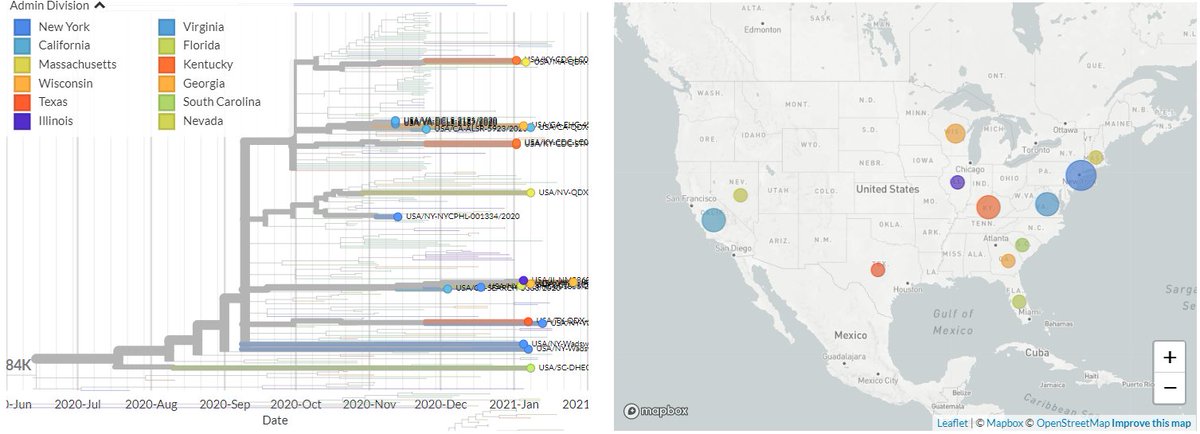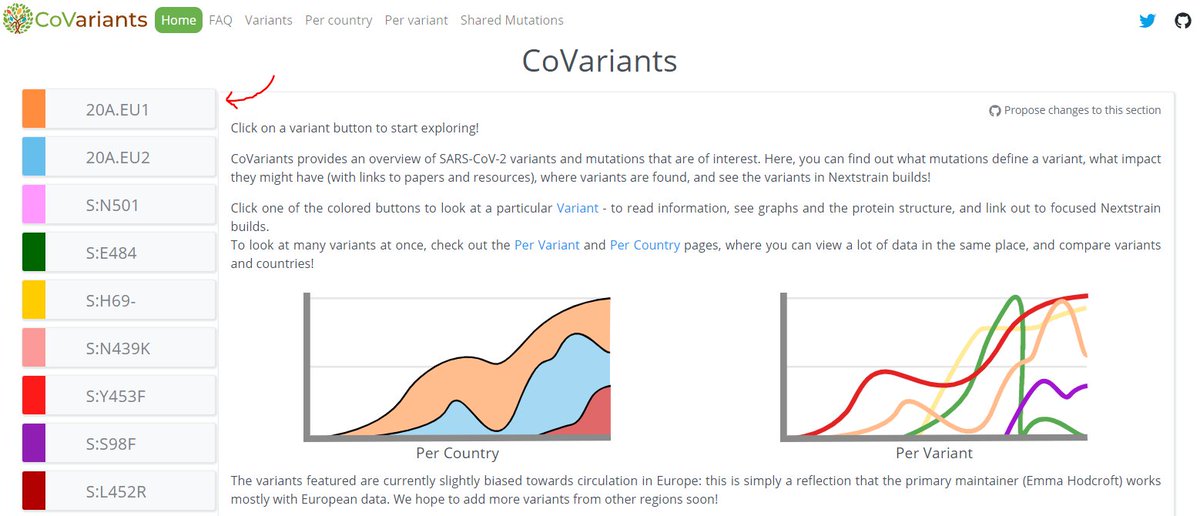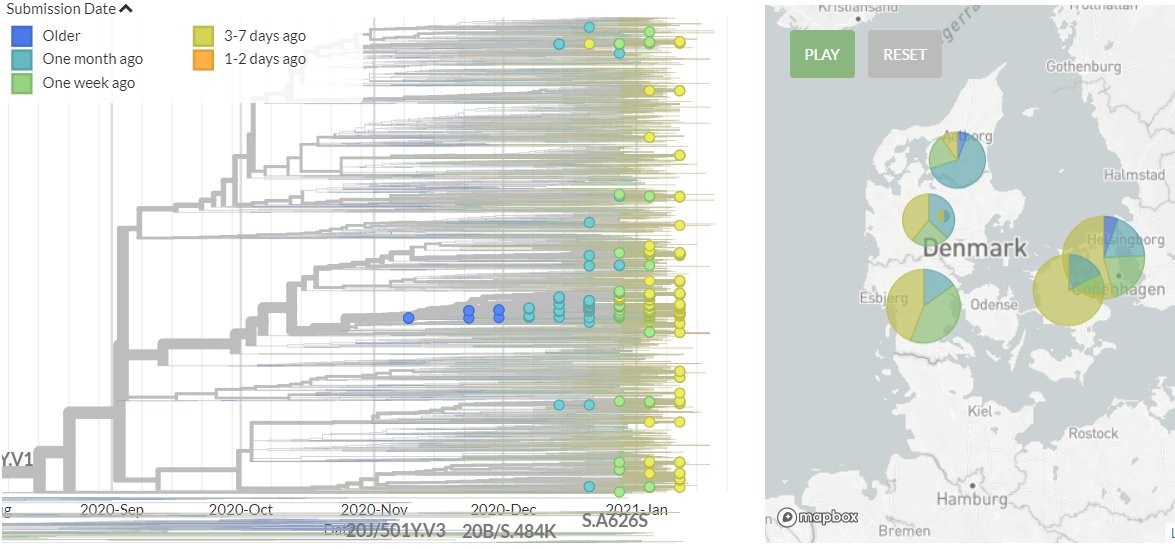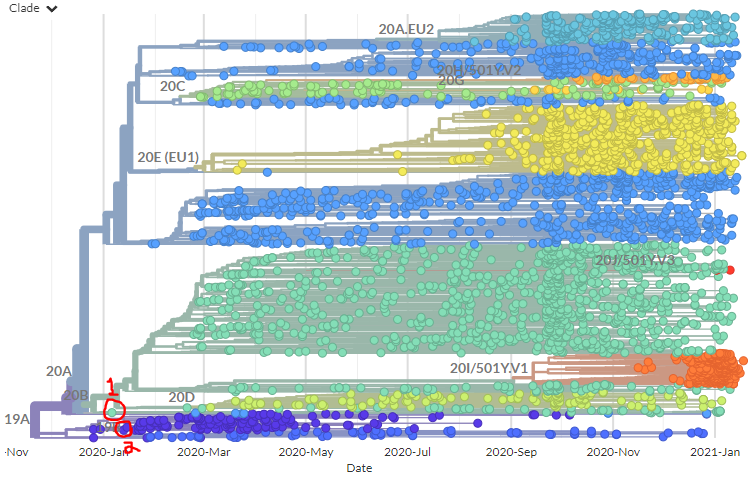
The new focal builds are now up, with data up to 2nd Feb.
Updated S:N501 build:
nextstrain.org/groups/neherla…
Updated S:E484 build:
nextstrain.org/groups/neherla…
1/15
Updated S:N501 build:
nextstrain.org/groups/neherla…
Updated S:E484 build:
nextstrain.org/groups/neherla…
1/15

Unfortunately it takes too long for me to do the detailed tweet threads I did originally. However, I'll try to hit a few highlights...
In 20I/501Y.V1 (B.1.1.7):
2/15
In 20I/501Y.V1 (B.1.1.7):
2/15
The Netherlands now has over 300 sequences in 501Y.V1, with clear signs of community transmission.
3/15
3/15

Spain has over 250 sequences in 501Y.V1 (most recent in yellow/orange). These include some clear local transmission clusters.
4/15

4/15


France has almost 200 sequences in 501Y.V1 now (most recent in yellow/orange. There are some clustering patterns that could suggest local transmission.
5/15

5/15


Ireland now has 240 sequences in 501Y.V1. These include clusters of what appears to be local transmission.
6/15

6/15


Switzerland now has 112 sequences in 501Y.V1. There are clusters that suggest ongoing local transmission.
7/15

7/15


Belgium has almost 200 sequences in 501Y.V1, with clusters that suggest ongoing local transmission.
8/15

8/15


In 501Y.V2, Switzerland now has 11 sequences, indicating further introductions (pic 1).
France now has 28 sequence, including some large clusters indicating onward local transmission (pics 2 & 3).
10/15


France now has 28 sequence, including some large clusters indicating onward local transmission (pics 2 & 3).
10/15



Ireland now has 8 sequences in 501Y.V2, in what looks like 5 separate introductions (pic 1)
The Netherlands now has 22 sequences in 501Y.V2, including some small clusters that may indicate local transmission, or a common exposure source (pics 2 & 3)
11/15


The Netherlands now has 22 sequences in 501Y.V2, including some small clusters that may indicate local transmission, or a common exposure source (pics 2 & 3)
11/15



Mozambique has 19 sequences in 501Y.V2, indicating many introductions (pic 1).
There are also sequences from Panama (1), USA (1), Zimbabwe (2), United Arab Emirates (6), Portugal (1), and Luxembourg (6) (pic 2).
12/15

There are also sequences from Panama (1), USA (1), Zimbabwe (2), United Arab Emirates (6), Portugal (1), and Luxembourg (6) (pic 2).
12/15


In 501Y.V3 (P.1), we can now see sequences from Italy and the Faroe Islands, alongside the sequences from Brazil and Japan.
13/15
13/15

In 20B/S:484K, the USA now has 23 sequences that fall in this variant.
Canada has 11 sequences, all from Ontario, in 20B/S:484K, including some clusters that may indicate onward local transmission or a common exposure source.
14/15


Canada has 11 sequences, all from Ontario, in 20B/S:484K, including some clusters that may indicate onward local transmission or a common exposure source.
14/15



The UK has 15 sequences in 20B/S:484K, including clusters that may represent ongoing local transmission.
There are also sequences from Switzerland (3), French Guiana (mapped to France) (1), Luxembourg (1), Netherlands (2), Ireland (3), and Italy (2) (pic 2).
15/15

There are also sequences from Switzerland (3), French Guiana (mapped to France) (1), Luxembourg (1), Netherlands (2), Ireland (3), and Italy (2) (pic 2).
15/15


Did I miss your country? I'm sorry! But you can check for yourself 😁
Just navigate to the build you're interested in, zoom in to your cluster of interest (you can also 'Filter' to it) then type your country's name into the 'Filter' box so that you only show those tips!
Just navigate to the build you're interested in, zoom in to your cluster of interest (you can also 'Filter' to it) then type your country's name into the 'Filter' box so that you only show those tips!
• • •
Missing some Tweet in this thread? You can try to
force a refresh





















